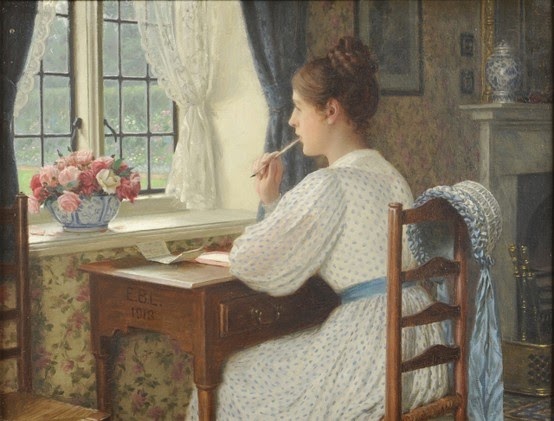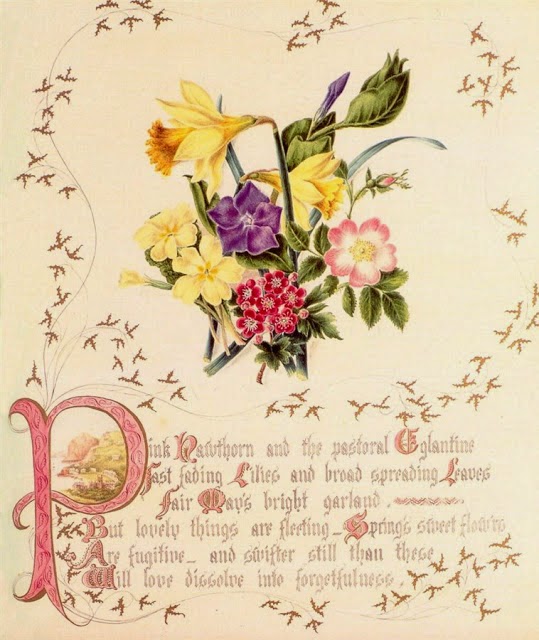O Ascolta, O senti come sottile e chiaro,
E più sottile, e più chiaro, andando più lontano!
O dolce e lontano da balze e dirupi
I corni della terra degli Elfi lievemente soffiano!
Soffia, lasciaci udire la risposta delle valli purpuree:
[Soffia, tromba;] rispondete, echi, morenti, morenti, morenti.
O hark, O hear how thin and clear,
And thinner, clearer, farther going!
O sweet and far from cliff and scar
The horns of Elfland faintly blowing!
Blow, let us hear the purple glens replying:
[Blow, bugle;]2 answer, echoes, dying, dying, dying.
Alfred Lord Tennyson, from The splendour falls on castle walls
Sì, sui versi di Tennyson, vi porto oggi con me nella terra degli Elfi, dove risuonano ancora gli echi di tempi lontani, insieme con quelli della Natura ... è la voce dell'autunno a soffiare per noi nelle sue trombe, con i suoi toni caldi, le sue inconfondibili luci, il suo calore ...
Una voce che ci racconta che quello dell'inizio dell'autunno è un momento fatto d'istanti in cui s'incontra ciò che ha già esaurito la propria linfa vitale
con ciò che dall'autunno scorso attende di mostrarsi, esibendo, quasi come un ultimo cenno di saluto, le poche energie che la Terra ha serbato prima del lungo sonno invernale.
con ciò che dall'autunno scorso attende di mostrarsi, esibendo, quasi come un ultimo cenno di saluto, le poche energie che la Terra ha serbato prima del lungo sonno invernale.
Sono più miti le mattine
E più scure diventano le noci
La Rosa non è più in città.
The morns are meeker than they were -
The nuts are getting brown -
The berry’s cheek is plumper -
The rose is out of town.
Emily Dickinson, from 12, (1858)
Corolle dai colori forti e decisi che guardano il cielo di ottobre e svettano ancora impavide, certe di riuscire a rallegrarci i cuori prima che il gelo sopraggiunga a spegnere le briose sfumature, rendendo, con la sua coltre cristallina, tutto velatamente uniforme, rallegrano le ore intiepidite da un godibile sole ...
Vi sto accompagnando con queste fotografie nei giardini del sud est dell'Inghilterra, esattamente nell'East Sussex, gentilmente donatemi ancora una volta dalla dolcissima amica Cristina, dove l'autunno sta esibendo compiutamente le sue caratteristiche di luce e sta elargendo i suoi caratteristici doni .... se la primavera e l'estate sono le stagioni dei colori e dei profumi, l'autunno è quella dei colori, dei profumi e della luce ....
L'estate ha Inizio due volte -
Inizia una volta in Giugno -
Inizia ad Ottobre
Ancora, commovente -
Forse senza il Tripudio
Ma più vivida in Grazia -
Com'è più bello è il Viso di chi parte
Del Viso di chi rimane -
Se ne va allora - per sempre -
Per sempre - fino a Maggio -
Ma "per sempre" è transitorio -
eccetto per coloro che dipartono -
LEONARDO ( 23 / 9 / 1986 - 10 / 10 / 1996 )
Summer has two Beginnings -
Beginning once in June -
Beginning in October
Affectingly again -
Without, perhaps, the Riot
But graphicer for Grace -
As finer is a going
Than a remaining Face -
Departing then - forever -
Forever - until May -
Forever is deciduous -
Except to those who die -
Emily Dickinson, 1422 (1877)
Tutte le fotografie che fanno parte di questo mio scritto, eccetto quella del mio amato Leonardo, sono state scattate dalla cara amica Cristina Rebeccani Coretti, che con il cuore ringrazio per la delicatezza del suo animo, presso Nyman Gardens, Hinton Ampner, Sandhill Farm, Sussex Prairies e Durrance Manor.
E grazie a voi tutti per avermi fatto compagnia in questa piacevolissima passeggiata illuminata dal prezioso sole autunnale compiuta sotto la guida di versi nobili ed altisonanti cui sono particolarmente legata !
A presto ♥
EMILY DICKINSON - TUTTE LE POESIE, Arnoldo Mondadori Editore S.p.A., Milano, 1997
Henry Van Dyke, D. Laurance Chambers, Poems of Tennyson, BiblioBazaar Publisher, 2010
... And Autumn comes to the Land of the Elves - East Sussex Gardens in Autumn.
O hark, O hear how thin and clear,
And thinner, clearer, farther going!
O sweet and far from cliff and scar
The horns of Elfland faintly blowing!
Blow, let us hear the purple glens replying:
[Blow, bugle;]2 answer, echoes, dying, dying, dying.
- picture 1
O love, they die in yon rich sky,
They faint on hill or field or river:
Our echoes roll from soul to soul
And grow for ever and for ever.
Blow, bugle, blow, set the wild echoes flying,
[And]2 [answer, echoes]3, dying, dying, dying.
Alfred Lord Tennyson, from The splendour falls on castle walls
Yes, on the verses of Tennyson, today I take you with me to 'Elfland', where still resound the echoes of long ago, along with those of Nature ... It is the voice of Autumn to blow for us its trumpets, with the its warm shades, its unique light, its glow ...
- picture 2
- picture 3
A voice telling us that the beginning of Autumn is a moment made of moments where what has already exhausted its lifeblood
- picture 4
- picture 5
- picture 6
meets what expects to show up since last fall, exhibiting, almost like a last nod, the little energy that the Earth has kept before the long Winter sleep.
- picture 7
- picture 8
- picture 9
The morns are meeker than they were -
The nuts are getting brown -
The berry’s cheek is plumper -
- picture 10
The rose is out of town.
- picture 11
Emily Dickinson, from 12, (1858)
Corollas by strong colors that look the October sky and soar yet fearless, certain to be able to rejoice our hearts before the frost happens turning off the lively hues, making, with its crystalline blanket, all uniformely veiled, delight the hours warmed by an enjoyable sun ...
- picture 12
- picture 13
- picture 14
- picture 15
- picture 16
alternating with others by slighter tones
- picture 17
- picture 18
With these gorgeous photographs I am accompanying in the gardens of south-eastern England, to be more precise in the East Sussex, kindly given me as a gift once again by my sweet friend Cristina, where Autumn is fully exhibiting the characteristics of light and is giving generously its typical gifts .... if Spring and Summer are the seasons of colors and scents, Autumn is the one of colors, scents and light ....
- picture 19
- picture 20
- picture 21
.... Only the rays of the Autumn sun are able to reveal to our eyes these reflections that seem stolen from precious metals ... all grasses are dressed to the nines enveloped by the rays of the planet that slowly, more and more, day after day, bows his head and walks away from us in order to conduct an Intelligent Everlasting, Unchanging Drawing ...
- picture 22
Summer has two Beginnings -
Beginning once in June -
Beginning in October
Affectingly again -
Without, perhaps, the Riot
But graphicer for Grace -
As finer is a going
Than a remaining Face -
Departing then - forever -
Forever - until May -
Forever is deciduous -
Except to those who die -
Emily Dickinson, 1422 (1877)
All photographs that are part of my writing, except that of my beloved Leonardo, were taken by my dear friend Cristina Rebeccani Coretti, whom I thank with all my heart for the delicacy of her soul, at Nyman Gardens, Hinton Ampner, Sandhill Farm, Sussex Prairies and Durrance Manor
And thanks to you all for having kept company to me in this pleasant walk, lit by the Autumn sun, had under the guidance of noble and lofty verses to which I'm particularly linked !
See you soon ♥
Bibliography:
EMILY DICKINSON - TUTTE LE POESIE, Arnoldo Mondadori Editore S.p.A., Milano, 1997
Henry Van Dyke, D. Laurance Chambers, Poems of Tennyson, BiblioBazaar Publisher, 2010
IMAGE-IN-ING
THURSDAY FAVORITE THINGS
TUESDAY WITH A TWIST
This post was featured by Angie at God's Growing Garden, my heart is filled to overflowing, thank you sweet friend !!!
FRIDAY, FOTO, FRIENDS
SIMPLE & SWEET FRIDAYS
THROUGH MY LENS
FLOWER WEDNESDAY
THURSDAY FAVORITE THINGS
TUESDAY WITH A TWIST
This post was featured by Angie at God's Growing Garden, my heart is filled to overflowing, thank you sweet friend !!!
FRIDAY, FOTO, FRIENDS
SIMPLE & SWEET FRIDAYS
THROUGH MY LENS
FLOWER WEDNESDAY
































.jpg)






%2Bin%2Bthe%2B1880s%2C%2BCelestino%2BDegoix%2B(%2Battivo%2Bdal%2B1860%2Bal%2B1890%2B).jpg)





